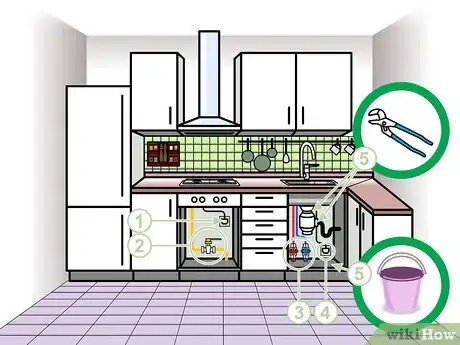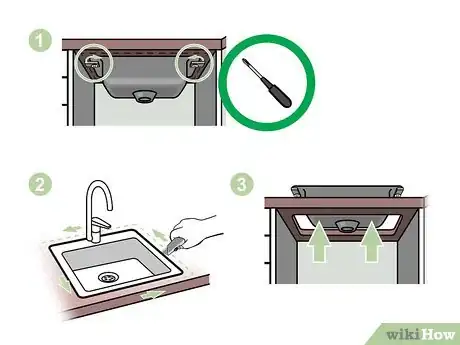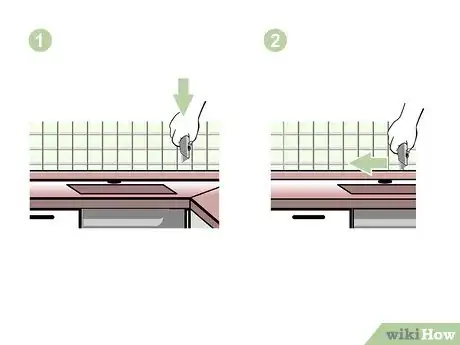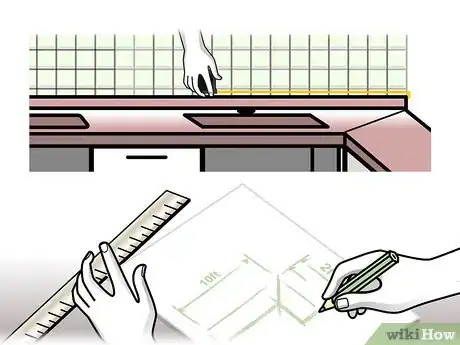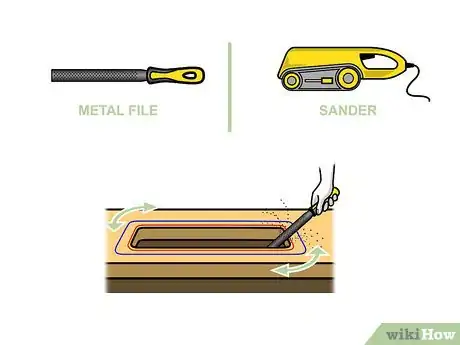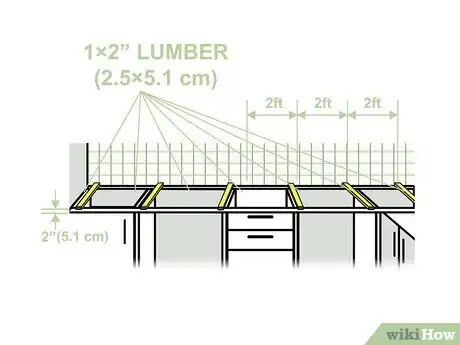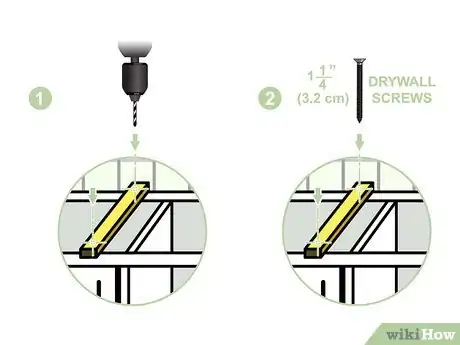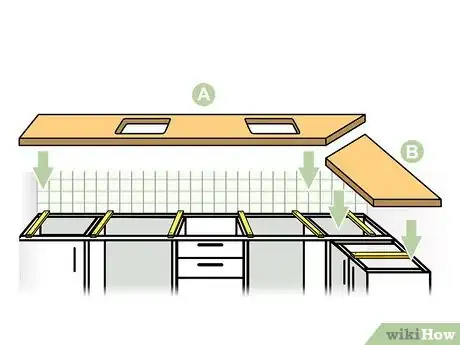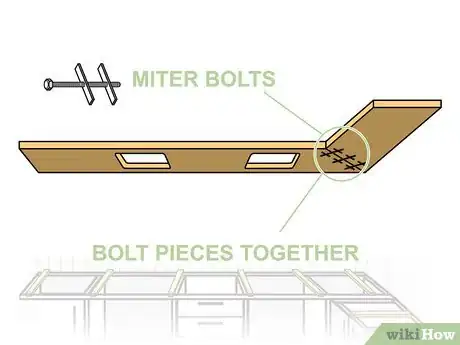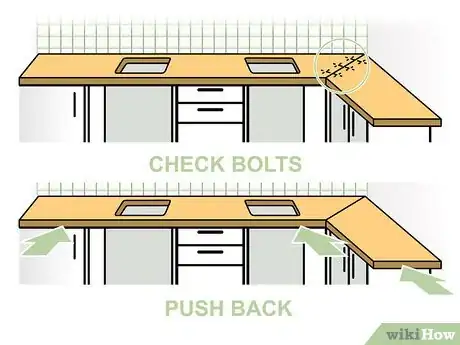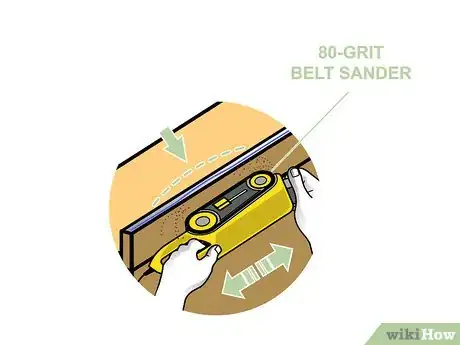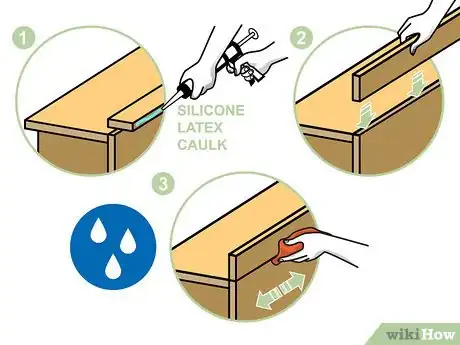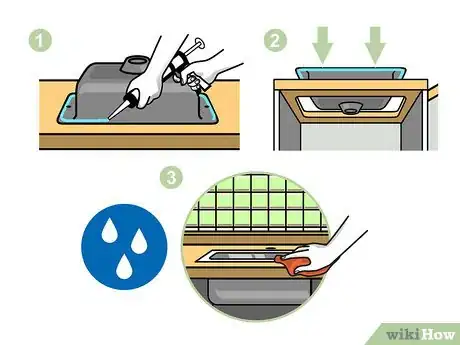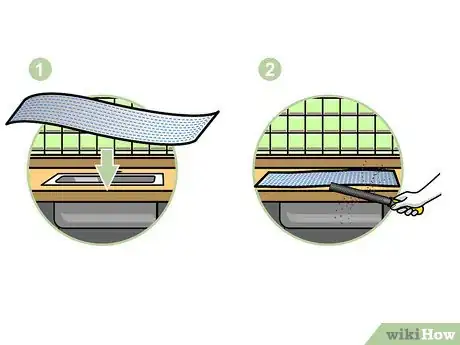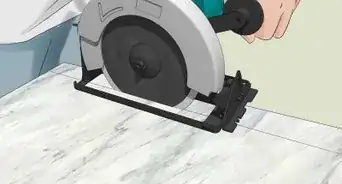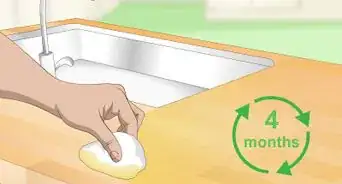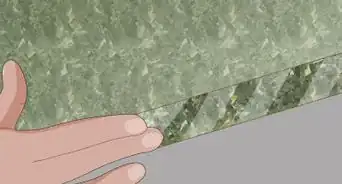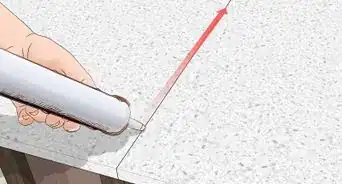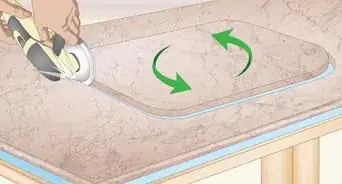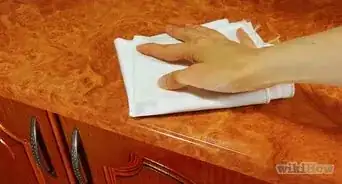This article was co-authored by Nick Yahoodain. Nick Yahoodain is a General Contractor and the CEO of Advanced Builders & Contractors in Los Angeles, California. With over 16 years of experience, Nick specializes in large residential projects such as new construction, developments, major renovations, additions, and hillside construction. Advanced Builders & Contractors is a member of the BBB, is licensed by the Contractors State License Board, and is fully bonded and insured. Advanced Builders & Contractors has been featured on NBC News, Elle Decor, Architectural Digest, and Voyage LA.
There are 13 references cited in this article, which can be found at the bottom of the page.
This article has been viewed 78,621 times.
You would like new countertops, but professional installation is costly. Fortunately, replacing laminate countertops is a project that you can tackle on your own. If you have a bit more skill, material such as granite, concrete, wood, and tile may also be used. To save time, measure out your countertops and order them pre-cut. Then, secure them to the wooden supports and fit the sink and range to make your countertops the best part of the room.
Steps
Removing Old Countertops
-
1Detach the water and gas supply lines. First, turn off the lines by finding the shutoff valves under the sink and range or by turning off the main valve in the basement. Use pliers to twist the ring-shaped nuts to remove the drain pipe and p-trap.[1]
- Place a bucket under the pipes to catch any water left in them.
- If you have a garbage disposal unit attached to your sink, don’t forget to unplug the cord from the outlet.
- Even if the lines are disconnected, use extra caution when you're working around these areas. You don't want to accidentally puncture one of the lines and cause a leak.[2]
-
2Loosen the mounting screws and caulk to remove the sink and range. Look underneath the sink or range to find screwed clamps securing these features to the countertops. Use a screwdriver to loosen these, then slice the caulk around the top of the sink or range with a utility knife.[3]
- Once finished, push the sink or range from the bottom to lift it off the countertop.
- Make sure the unit is off to the unit if you’re removing an electric range. Disconnect the power wires in the metal box behind the range to pull the range out.
Advertisement -
3Slice through the caulking on countertops with wall backsplashes. If your countertop has a backsplash secured to the wall, it’ll also have caulking. Hold your utility knife vertically. Run the tip through the caulking all the way to the other end of the backsplash.
-
4Detach the fasteners on the old countertops. Remove the drawers and cabinet doors and look at the underside of your countertop. Locate the screws fastening the wood supports and cabinets. Undo these screws to free the countertop and move it from the wooden supports.[4]
- Stubborn countertops, particularly older ones installed incorrectly, need to be pried off the countertops with a pry bar. Pry up 1 inch (2.5 cm) and then move 12 inches (30 cm) down the length of your countertop until you reach the end. Then you can use a larger pry bar to lift the entire countertop. You may also slip a reciprocal saw between the countertop and cabinets to cut screws and nails.[5]
- Work slowly and carefully to avoid damaging your counters, backsplash, or appliances.[6]
- Many marble or granite countertops are only put on with adhesives rather than screwed in.
Cutting and Fitting Laminate Countertops
-
1Measure the space required for the countertops. Run a tape measure along the space where the countertop will rest. If you have your old countertops on hand, they may serve as a useful guide. Note the dimensions the countertops need to be.[7]
- When building around a corner in your room, plan on connecting 2 countertops cut diagonally. Adjust your measurements to fit these pieces.
-
2Cut the countertops to size. Put on safety goggles and a dust mask first to protect yourself from flying shards and material particles. For synthetic countertops like laminate, use a fine-tooth handsaw or jigsaw to fashion the countertops. Placing masking tape over the cutting lines can reduce splintering.[8]
- To save time, order the countertops pre-cut. Measure your space before placing the order. You may still need to make some cuts to fit the countertops once you have them.
-
3Trace the sink and range space on the countertop. You may want to set the countertop in place first to get a better idea of where these features need to go. Flip the sink or range over, then use a pencil to trace around their perimeter. Trace a second outline 1⁄2 in (1.3 cm) inside the first one on all sides.[9]
- Your sink or range may have come with a template to be used when sketching the outline. If it doesn’t, use posterboard or cardboard to trace your own sink or range template.
- The trace lines can be hard to see against dark countertops. Place masking tape first and trace over it to make the lines more visible.
-
4Cut out the sink or range space. Get your saw and put on your safety gear again. The part you want to cut is the second, smaller outline. Drill holes large enough to fit your saw blade in each corner of your countertop. Cut all the way around the outline and clear away the excess material.[10]
-
5File down the cuts until they’re smooth. A metal file or sander works well. Go across each cut, filing in one direction only. Be sure to get the inside of the countertop where you cut the space for the sink or range. When the edges feel smooth and safe to the touch, you’re ready to move on.[11]
-
6Check to see that the countertops fit over the cabinets. Place the countertops on the wooden supports or measure their front edges. If they’re not high enough, the front will overhang and block the cabinet doors. You’ll need to add build-up strips.
-
7Measure and cut build-up strips out of wood. These strips are easily made at home with 1 in × 2 in (2.5 cm × 5.1 cm) lumber. Measure along the countertop’s back and sides. The build-up strips run from back to front and need to be installed every 2 ft (0.61 m) along the countertop’s length.[12]
- Some countertops come packaged with these strips, so you won’t have to make them yourself.
-
8Lay the build-up strips on top of the cabinets. Start at one end of the cabinet structure where the countertop will rest. Measure 2 in (5.1 cm) from the end and lay the first strip. Its ends should rest on the front and back edges of the cabinet. Continue laying these strips every 2 ft (0.61 m).[13]
- Remember to keep the end strips 2 in (5.1 cm) from the cabinet’s edge.
-
9Fasten the strips in place with screws. Drill a hole in both ends of the strips, directly over the cabinet frame. Place 1 1⁄4 in (3.2 cm) drywall screws in each hole. Turn the screws with a cordless screwdriver to secure the strips in place.[14]
-
10Fit the countertop pieces together. Lay them on top of the build-ups and ensure they connect smoothly. In particular, pay attention to where 2 pieces of countertop meet. Make any adjustments you need by reducing the size of the build-up strips or the countertops themselves.
-
11Bolt the countertop pieces together. Pre-cut countertops should come with miter bolts to fasten the countertop pieces together. Place the miter bolts in the miter joins on the undersides of the countertops, then twist the end of the bolt to secure everything in place.[15]
- If you cut the countertops yourself, make miter joints first to fit the countertops together. These can be tricky to make, so consider hiring a professional.
- Another way to connect countertop pieces is to get an aluminum joining strip from the store. Cut it to size, then screw it to the side of the countertop. Slide the other countertop piece into the joining strip’s groove.
Installing and Finishing the Countertop
-
1Slide the countertops back against the wall. Make sure the countertops are securely bolted together first. Push them all the way back and gauge how much of a gap remains between the countertop and wall. Most likely, you’ll notice a gap that needs to be fixed.[16]
-
2Scribe the backsplash. Lay masking tape over the top of the backsplash. Get a scribing tool, and find the largest gap between the countertop and wall. Lay the tool flat against the wall and adjust the pencil end so the tip is on the edge of the tape. Keep the scribing tool at this length and draw the line all the way across the tape.[17]
- The countertop should be as level and close to the wall as possible. You may need to add shims under the counter or scribe and sand the cabinet’s sides to do this.
-
3Sand the countertop down to the scribe line. Undo the bolts underneath the counter. Pull the pieces out and get an 80-grip belt sander. Wear down the back part of the counter to the line you traced. Hold the sander flat at all times.[18]
-
4Repeat sanding until the countertop is flat against the wall. Reattach the bolts to hold the countertops in place. Push them against the wall and measure them again with the scribing tool. You may need to sand 1 or more times to eliminate unsightly gaps larger than 3⁄16 inch (4.8 mm).
-
5Caulk the miter joints to secure the countertops together. You’ll need to undo the miter bolts one last time. Slide the countertops apart. Apply a bead of silicone caulk along the miter joints on the countertop edges. Then push the countertops together and secure the bolt in place one last time.[19]
- When using aluminum strips instead of miter joints, you won’t need to do this, so enjoy skipping the extra work.
-
6Screw the countertops to the cabinets. The easiest way to do this is to drill up through the build-up strips. Apply the screws so they enter but don't exit the countertop. For extra support, place small angle brackets along the build-up strips. Screw the brackets into the countertop and the cabinets to hold them in place.[20]
- 1 1⁄4 in (32 mm) drywall screws are commonly used for this. Double-check the thickness of your countertop and build-up strips and get longer or shorter screws as needed.
- To prevent any damage to the countertops, measure the countertop depth first. You can then measure that far down from the tip of your drill bit and place a piece of tape there to show you when to stop.
-
7Place caulk along the backsplash. Finish sealing the countertop by securing the backsplash to the wall. Squeeze a bead of caulk into the gap and move the caulk gun all the way across the backsplash in one motion. Moisten a rag and use it to smooth out the caulk.[21]
- Silicone latex caulk is the best choice since it’s both water-resistant and paintable.
-
8Seal the sink and range in place with caulk. Flip these objects over and find your tube of silicone caulk. Spread a bead of the caulk all around the edge of the sink or range. When finished, carefully pick up the object and lay it into the hole you cut earlier. Wipe away any excess caulk with a rag.[22]
-
9Cut the laminate side strips to fit the countertop’s edges. These strips should be included with the countertop. If they haven’t been pre-cut, measure the length of the free edges of the countertops. Snip the strip to size with a pair of scissors.[23]
-
10Use contact cement to glue the side strips in place. Brush a layer of contact cement over the backs of the side strips. Wait about 20 minutes for the glue to feel dry to the touch. Press the strips to the countertop’s edges to hold them in place.[24]
- It helps to place a towel over the countertop to avoid getting the glue on it.
-
11File down the laminate strips. Before you begin, place a towel over the countertop to avoid damaging it. Hold a metal file flat against the towel and carefully wear down the excess on the strips. Take your time getting the strips to blend in so you avoid scratching your new countertop.[25]
Expert Q&A
Did you know you can get expert answers for this article?
Unlock expert answers by supporting wikiHow
-
QuestionCan I keep the plywood under my original countertop?
 Nick YahoodainNick Yahoodain is a General Contractor and the CEO of Advanced Builders & Contractors in Los Angeles, California. With over 16 years of experience, Nick specializes in large residential projects such as new construction, developments, major renovations, additions, and hillside construction. Advanced Builders & Contractors is a member of the BBB, is licensed by the Contractors State License Board, and is fully bonded and insured. Advanced Builders & Contractors has been featured on NBC News, Elle Decor, Architectural Digest, and Voyage LA.
Nick YahoodainNick Yahoodain is a General Contractor and the CEO of Advanced Builders & Contractors in Los Angeles, California. With over 16 years of experience, Nick specializes in large residential projects such as new construction, developments, major renovations, additions, and hillside construction. Advanced Builders & Contractors is a member of the BBB, is licensed by the Contractors State License Board, and is fully bonded and insured. Advanced Builders & Contractors has been featured on NBC News, Elle Decor, Architectural Digest, and Voyage LA.
General Contractor
wikiHow Video: How to Replace Countertops
Things You’ll Need
- Cordless screwdriver
- Belt sander
- Caulk gun
- Jigsaw
- Clamps
- Cordless drill
- File
- Scribing tool
- Tape measure
- Masking tape
- Dust mask
- Safety goggles
- Steel angles
- Drywall screws
- 80-grit sanding belt
- Silicone caulk
- Silicone latex caulk
References
- ↑ http://www.easy2diy.com/cm/easy/diy_ht_3d_index.asp?page_id=35743484
- ↑ Nick Yahoodain. General Contractor. Expert Interview. 6 October 2020.
- ↑ http://www.planitdiy.com/how-to/plumbing/how-to-replace-your-kitchen-sink/
- ↑ http://www.easy2diy.com/cm/easy/diy_ht_3d_index.asp?page_id=35743484
- ↑ https://www.todayshomeowner.com/video/how-to-remove-and-install-plastic-laminate-kitchen-countertops/
- ↑ Nick Yahoodain. General Contractor. Expert Interview. 6 October 2020.
- ↑ http://www.loveandrenovations.com/replace-countertop/
- ↑ http://www.finehomebuilding.com/2014/02/21/how-to-cut-an-opening-for-a-sink-in-a-laminate-counter-top
- ↑ http://www.finehomebuilding.com/2014/02/21/how-to-cut-an-opening-for-a-sink-in-a-laminate-counter-top
- ↑ http://www.finehomebuilding.com/2014/02/21/how-to-cut-an-opening-for-a-sink-in-a-laminate-counter-top
- ↑ https://www.familyhandyman.com/kitchen/countertops/how-to-install-a-countertop/view-all/
- ↑ https://www.familyhandyman.com/kitchen/countertops/how-to-install-a-countertop/view-all/
- ↑ https://www.thisoldhouse.com/how-to/how-to-build-laminate-counter
- ↑ https://www.familyhandyman.com/kitchen/countertops/how-to-install-a-countertop/view-all/
- ↑ https://www.todayshomeowner.com/video/how-to-install-plastic-laminate-kitchen-countertops/
- ↑ https://www.thisoldhouse.com/how-to/how-to-build-laminate-counter
- ↑ https://www.familyhandyman.com/tools/how-to-scribe-for-a-perfect-fit/view-all/
- ↑ https://www.familyhandyman.com/kitchen/countertops/how-to-install-a-countertop/view-all/
- ↑ https://www.familyhandyman.com/kitchen/countertops/how-to-install-a-countertop/view-all/
- ↑ https://www.thisoldhouse.com/how-to/how-to-build-laminate-counter
- ↑ https://www.homeadvisor.com/r/bathroom-counter-replacement/
- ↑ https://www.bobvila.com/articles/install-kitchen-sink/
- ↑ https://www.familyhandyman.com/kitchen/countertops/how-to-install-a-countertop/view-all/
- ↑ https://www.thisoldhouse.com/how-to/how-to-laminate-countertop
- ↑ https://www.familyhandyman.com/kitchen/countertops/how-to-install-a-countertop/view-all/
About This Article
To replace countertops, first detach all energy supply lines and remove the sink, range, and old countertops. Next, cut your new countertops to the correct size, set the countertops down, and cut out the shapes of the appliances. After that, bolt the countertop pieces together, slide them against the wall, and scribe the backsplash. Then, sand the countertop down to the scribe line, caulk the miter joints, and screw the countertops to the cabinets. Finally, use caulk to secure the countertops, sink, and range, and use contact cement to add laminate strips to the edges. For more guidance, like how to add build-up strips, read on!
